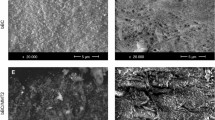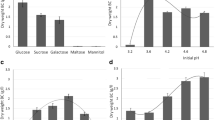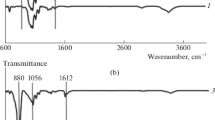Abstract
Bacterial cellulose obtained through fermentation by the Acetobacter xylinum is of superior functional quality in comparison to plant cellulose. Various alkali treatment methods were used to process bio-chemically complex pellicle into a clean cellulose membrane/sheet. The effect of potassium hydroxide, sodium carbonate and potassium carbonate was found to be milder on the final cellulose product in contrast to the widely used sodium hydroxide treatment. These novel treatment methods also caused improvement in the tensile strength of the membranes in comparison to sodium hydroxide. The overall quality of the 0.1 M sodium carbonate- and potassium carbonate-treated cellulose was superior, as the membranes displayed maximum tensile strength and elongation next to the native membrane. The low tensile strength of sodium hydroxide-treated membrane is attributed to its higher swelling characteristics in alkali. Further, the low swelling property of sodium carbonate- and potassium carbonate-treated membranes resulted in their high oxygen transmission rates (low oxygen barrier). Hunter lab colour parameters were determined to assess the effect of different alkali treatments on the colour characteristics of the membranes. Further, based on the high mechanical strength and comparatively low oxygen transmission rates, the processed cellulose membranes may find application as a bio- packaging material for controlled atmosphere packaging, where hydrophilic membranes with high oxygen barrier and water vapour permeation are desirable.
Similar content being viewed by others
References
R.H. Atalla D.L. Vanderhart (1984) ArticleTitleNative cellulose a composite of two distinct crystalline forms Science 223 283–285 Occurrence Handle1:CAS:528:DyaL2cXhtFKksbc%3D
F.M. Clydesdale (1978) ArticleTitleColorimetry methodology and applications CRC Critical Reviews in Food Science and Nutrition 10 243–302 Occurrence Handle1:CAS:528:DyaE1MXosFensQ%3D%3D Occurrence Handle10.1080/10408397809527252
V. Dubey C. Saxena L. Singh K.V. Ramana R.S. Chauhan (2002) ArticleTitlePervaporation of binary water–ethanol mixtures through bacterial cellulose membrane Separation and Purification Technology 27 163–171 Occurrence Handle10.1016/S1383-5866(01)00210-6 Occurrence Handle1:CAS:528:DC%2BD38XivValur8%3D
G.I. Mantanis R.A. Young R.M. Rowell (1995) ArticleTitleSwelling of compressed cellulose fibre webs in organic liquids Cellulose 2 1–22 Occurrence Handle1:CAS:528:DyaK28Xls1CjsLY%3D
M. Matsuoka T. Tsuchida K. Matsushita O. Adachi F. Yoshinaga (1996) ArticleTitleAsynthetic medium for bacterial cellulose production by Acetobacter xylinum Bioscience Biotechnology and Biochemistry 60 575–579 Occurrence Handle1:CAS:528:DyaK28Xislahs7s%3D
T. Oikawa T. Morimo M. Ameyama (1995) ArticleTitleProduction of cellulose from D-arabitol by Acetobacter xylinum Bioscience Biotechnology and Biochemistry 59 1564–1565 Occurrence Handle1:CAS:528:DyaK2MXnvFKms70%3D
K.V. Ramana A. Tomar L. Singh (2000) ArticleTitleEffect of various carbon and nitrogen sources on cellulose synthesis by Acetobacter xylinum World Journal of Microbiology and Biotechnology 16 245–248 Occurrence Handle10.1023/A:1008958014270 Occurrence Handle1:CAS:528:DC%2BD3cXlvVyktb0%3D
Ramana, K.V., Singh L., Ganesan K., Jeevaratnam K., Chauhan R.S., 2001 Pervaporation performance of chemically modified bacterial cellulose membrane (MBCM): dehydration of aqueous–organic mixtures, Proceedings of International Conference on New Horizons in Biotechnology, RRL, Trivandrum, India, p. 142
Singh, L., Ramana K.V., Banerjee S., Dubey V. & Chauhan R.S. 1996 Studies on bacterial cellulose membrane production and its structural properties. Proceedings of the XIV National Symposium on Membranes in Chemical and Biochemical Industries, Indian Institute of Technology, Delhi, India, p. 31–34
R. Serafica R. Mormino H. Bungay (2002) ArticleTitleInclusion of solid particles in bacterial cellulose Applied Microbiology and Biotechnology 58 756–760 Occurrence Handle1:CAS:528:DC%2BD38XktFCqtbY%3D
K. Watanabe S. Yamanaka (1995) ArticleTitleEffect of oxygen tension in the gaseous phase on production and physiological properties of bacterial cellulose formed under static culture conditions Bioscience Biotechnology and Biochemistry 59 65–68 Occurrence Handle1:CAS:528:DyaK2MXjslKrt78%3D
C.J. Weber (2000) Biobased Packaging Materials for the Food Industry; Status and Perspectives The Royal Veterinary and Agricultural University Denmark
Author information
Authors and Affiliations
Corresponding author
Rights and permissions
About this article
Cite this article
George, J., Ramana, K.V., Sabapathy, S.N. et al. Physico-Mechanical Properties of Chemically Treated Bacterial (Acetobacter xylinum) Cellulose Membrane. World J Microbiol Biotechnol 21, 1323–1327 (2005). https://doi.org/10.1007/s11274-005-3574-0
Received:
Accepted:
Issue Date:
DOI: https://doi.org/10.1007/s11274-005-3574-0




